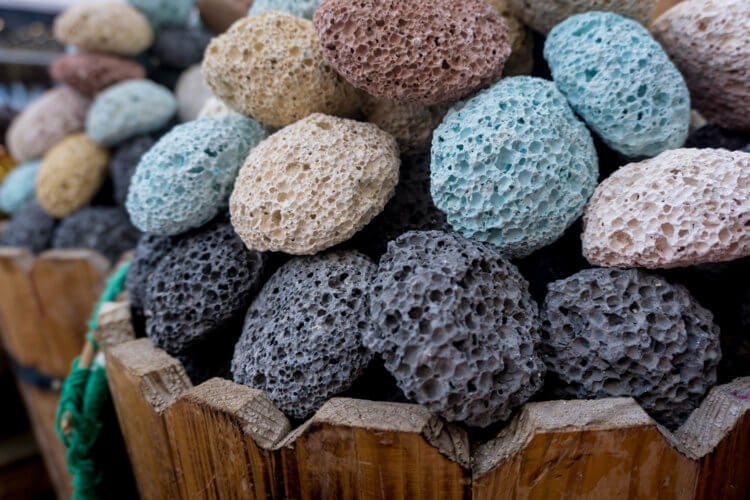Pumice is a popular foot care accessory that people have been using for cosmetic purposes for many years. As a rule, it is a small block of white, blue, green, brown, brown or even black. However, many people have no idea what this material is or where it comes from. In fact, pumice is not specially made, and is not even tinted. It is only given the required size and shape. It is a natural stone that occurs as a result of volcanic eruptions. In essence, pumice is volcanic glass (pumicite).

Pumice stone is known to many people as a means for caring for the feet. Photo source: laparet.ru
Contents
- 1 What is pumice and how does it arise
- 2 What determines the color of pumice
- 3 Where is pumice mined
- 4 What is pumice used for
What is pumice and how does it occur
The name “pumice” itself originated in the 18th century in the Netherlands from the Latin word “pumex”, which has the same root as another Latin word “spuma”, which means “foam”. Pumicite, or penza, as mentioned above, is a volcanic glass that hardens under conditions of strong gas emission. It consists of 75% quartz and also contains a large number of minerals known as feldspars. In addition, pumice includes such crystalline materials as plagioclase, monoclinic and rhombic pyroxene and mica.
The process of foam formation can be imagined as an “eruption” of carbonated water, which occurs when you suddenly open the cap of a bottle. As a result of a sharp decrease in pressure, there is an active release of gases, as a result of which the water turns into foam and increases in volume. If the water also quickly hardened, it would also be a foamy material resembling foam.

Pumice occurs as a result of volcanic eruptions. Photo source: bestlj.ru
Approximately the same processes occur in volcanic material during a volcanic eruption. But, since lava hardens quickly, the bubbles formed by gases provide pumice with porosity, which reaches 80%.
What determines the color of pumice
As mentioned above, pumice is not specially tinted. It has a natural color that varies depending on the composition of the stone. The color is especially strongly influenced by the valence of iron contained in the composition. For example, the darker the color of the stone, the more mixed-valent iron it contains.
Yellow and blue shades arise as a result of mixing silicon melt with oxides of nickel, titanium, and calcium. Accordingly, different contents of these elements lead to the appearance of different shades.

In Russia, pumice is mined in Kamchatka. Photo source: www.kp.ru
Where pumice is mined
As we found out, pumice is a volcanic material. At first glance, it may seem that it can be found everywhere near volcanoes. But in reality this is not so – over time, the stone loses its properties and begins to collapse. This means that the material must be fresh.
Considering all of the above, pumice is mined near active volcanoes or those that have only recently died out. By the way, in the world there are much more active volcanoes that are erupting right now than you can imagine. For example, in Russia, pumice is mined in Kamchatka, known for its volcanic activity, and the Kuril Islands. It is also mined in countries where there are active volcanoes – in Armenia, Italy, New Zealand, the USA, etc.
What is pumice used for?
Pumice has a number of unique properties. Due to the fact that it is porous, its volumetric mass is only 0.3-0.9 g/cm³. For example, pumice does not sink in water until it gets wet. In addition, it has excellent thermal insulation properties. At the same time, it is a fire-resistant and chemically inert material. Therefore, it is used not only for cosmetic purposes, but also as a building material.

Pumice is used as a filler for concrete. Photo source: designmarket.az
Pumice is often used as a filler in lightweight concrete (pumice concrete). This concrete has excellent thermal insulation properties. Pumice is also used as an additive to cement and lime. In the chemical industry, filters are made from it. It is also used to create glazes that cover, for example, ceramic tiles.
Be sure to visit our Zen and Telegram channels, here you will find the most interesting news from the world of science and the latest discoveries!
Due to its hardness and strength, pumice is used as an abrasive material for grinding wood and metal surfaces, as well as for polishing stone surfaces. Owners of birds and rodents give their pets pumice for grinding down claws, beaks and incisors. By the way, for birds the stone also serves as a source of minerals. Therefore, if you have a parrot at home, we recommend hanging a block of pumice in its cage — he will be grateful to you.